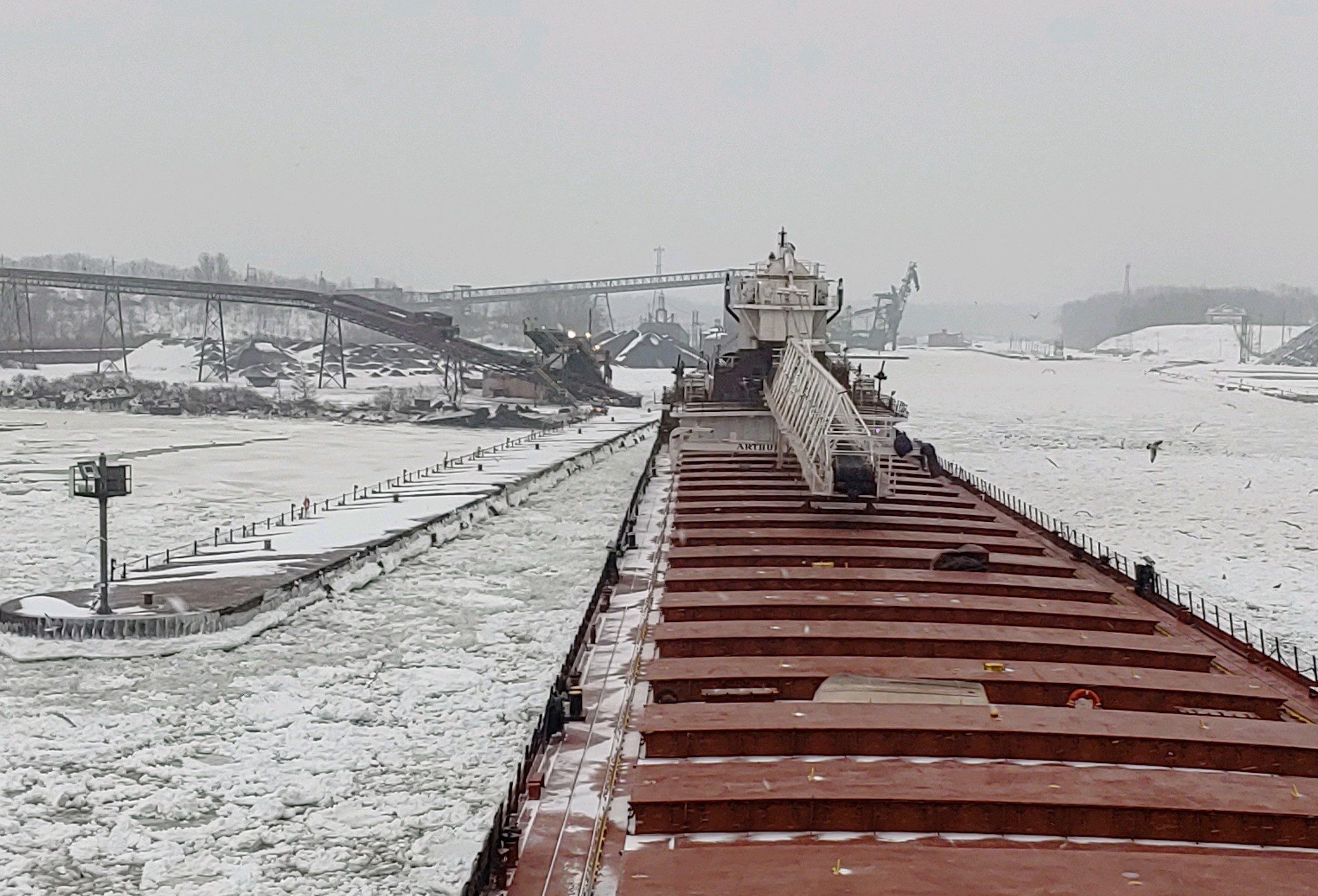Unions Slam Trump For Giving China A Pass On Shipbuilding
By Joe Deaux and Laura Curtis Nov 8, 2025 (Bloomberg) –A group of labor unions led by the United Steelworkers slammed the Trump administration for suspending port fees on Chinese ships...

A lack of U.S. Coast Guard icebreaking assets has delayed cargoes this season on the Great Lakes despite a relatively mild and delayed onset of winter in the region, the Great Lakes Maritime Task Force said Wednesday.
U.S.-flag “lakers” on 20 voyages, with a total of 750,000 tons of carrying capacity for iron ore, coal and cement, were delayed for a total of 325 hours, the group said.
The Great Lakes Maritime Task Force, with 74 members, is the largest coalition to speak for the Great Lakes Navigation System.
In one case involving the MV American Century, the ship became beset in the St. Mary’s River even after it cleared a regulatory check-in point in time to meet the scheduled closing of the Soo Locks in Sault Ste. Marie, Michigan. Coast Guard icebreakers were unable to free the vessel in time for its planned transit through the locks, which connect Lake Superior to Lake Huron. This delayed the downbound lockage’s of the last vessels leaving Lake Superior, including the Coast Guard Cutter Biscayne Bay, which left no icebreakers on Lake Superior during the lock closure.
The U.S. Coast Guard Cutter Alder, which is normally stationed in Duluth, Minnesota, is on the East Coast for an overhaul.
The ice-induced vessel delays also forced the Army Corps of Engineers to begin lock dewatering operations a day later than planned.
“The inefficiency introduced into the Great Lakes Navigation System by inadequate Coast Guard icebreaking resources impacts the carriers, their customers and the entire North American Manufacturing supply chain,” said Jim Weakley, President of Great Lakes Maritime Task Force, and the Lake Carriers’ Association. “The men and women of the U.S. Coast Guard do the best they can with the resources they are provided. Unfortunately, they do not have enough icebreakers to keep the system operating efficiently.”
Coast Guard icebreaking operations on the Great Lakes, known as Operation Taconite, typically begin on December 15, giving icebreaking assets one month before the scheduled closure of the Soo Locks on January 15. But this year the icebreaking operation was delayed until December 29, and the U.S. Coast Guard had four of its nine Great Lakes icebreakers in scheduled overhaul, scheduled maintenance, or unscheduled maintenance periods, according to the task force, and at one point in January, five of its eight icebreakers operating on the Great Lakes were simultaneously unavailable due to mechanical failures. A total of 68 icebreaking cutter days were lost due to equipment fires or engine breakdowns, the task force said.
“The lives of the professional women and men sailing aboard lakers, the safety of the vessels and the protection of the environment depend on adequate Coast Guard icebreakers,” said John Clemons, Great Lakes Maritime Task Force’s Vice President and with American Maritime Officers, AFL-CI). “In recent years, vessels have been sliced open, forced aground or collided with each other because of inadequate icebreaking resources.”
“The Port of Duluth-Superior is the Great Lakes’ top port by tonnage and one of the nation’s top twenty, but the Coast Guard doesn’t consider its waterways as ‘Tier I’ for icebreaking purposes,” says Deb DeLuca, executive director, Duluth Seaway Port Authority. “This is troubling given that Minnesota’s docks along the western edge of Lake Superior provide the iron ore to produce 80 percent of the nation’s first-pour steel. The Head of the Lakes is a vital link in North America’s domestic steel production supply chain.”
“Adequate icebreaking not only supports the Great Lakes Navigation System, but it also prevents flooding,” said Eric Peace, the Lake Carriers’ Associations’ Vice President and an experienced sailor. “Last February, we saw extensive flooding because of an ice dam in the St. Clair River. At the time the lone ‘heavy’ icebreaker operated by the Coast Guard was not available because it was undergoing repairs.”
Budget reconciliation legislation now being considered in the U.S. Senate would also provide the Coast Guard with funding for an additional Great Lakes icebreaker. Meanwhile, the Great Lakes Winter Commerce Act (S.576 and H.R.1561) would require the Coast Guard to report to Congress on its plans to improve Great Lakes icebreaking standards and capabilities.
“We need to build an additional Great Lakes icebreaker and pass the Great Lakes Winter Commerce Act. Both are needed to establish a track line, protect homeowners and keep commerce moving.” says Peace.

Sign up for gCaptain’s newsletter and never miss an update

Subscribe to gCaptain Daily and stay informed with the latest global maritime and offshore news
Essential news coupled with the finest maritime content sourced from across the globe.
Sign Up